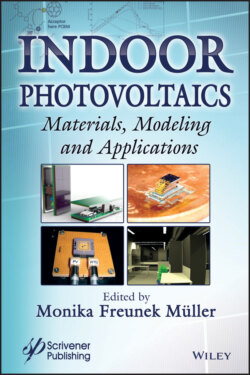Читать книгу Indoor Photovoltaics - Группа авторов - Страница 37
3.2 Indoor Spectra and Efficiencies
ОглавлениеOutdoor spectra are broadband spectra resulting from the thermal radiation of the sun. The human eye is sensitive only to a small fraction of it, which has also been characterized as the human visibility function V(λ) (see Chapter 4 and 5 for detailed introductions). The users of artificial light in indoor environments are humans, plants, and animals, so their radiation is optimized for their optical range of sensitivity, such as V(λ). Broadband radiation sources in indoor environments are halogen lamps and incandescent bulbs, as well as solar radiation filtered through a window. Depending on the place of installation, windows are manufactured with functional coatings of a spectral transmittance T(λ), such as heat or sun protection coatings. In general, the filtering function of these windows is optimized to V(λ). Thus, the indoor solar spectrum is different to the outdoor spectrum not only in its intensity, but also in its spectral distribution. Figure 3.1 depicts typical indoor spectra. The window spectra result is from the spectral irradiance of the so-called AM 1.5 solar spectrum [26] that is transmitted through a heat and sun protection coating of a window, respectively (see Chapter 4 for a detailed introduction).
As windows in most applications do not face the sky horizontally, the actual irradiance E will result from the incident power P received on an area A in an incident angle α following Eq. (3.1).
(3.1)
In some applications, a sensor might be directly installed on a window facing the outdoors. However, most devices will be installed within a certain distance to the window. As the intensity is inverse to the square of the distance from the emitter, the incident irradiance is additionally lowered following Eq. (3.2)
(3.2)
Figure 3.1 Spectra for sunlight through heat and sun protection windows, LED, and warm white fluorescent lamps. The emissions after 1800 nm are negligible for this visualization purpose.
Note that the discussion so far has only included direct radiation. Indirect radiation resulting from reflection or transmission indoors has been neglected. Its effects and modeling are discussed in detail in Chapter 4.
The photovoltaic efficiency limit for a conversion from optical radiation to photoelectric power depends on many parameters. Some of these parameters are spectrally dependent, such as the energy gap or the photon flow, that is the intensity of the radiation. The number of photons N(λ) per area A and time t yields the spectral photon flux ϕpλ
(3.3)
The thermodynamic limit to photovoltaic efficiencies presented by Shockley and Queisser was calculated for black body radiation following Planck’s law [16]. It assumes that an ideal single absorber material, where every incident photon is absorbed, yields the so-called external quantum efficiency EQE = 1. Then the short circuit current density jsc ≈ jph, where the photocurrent density jph is
(3.4)
with the elementary charge q = 1.602 10-19 As. The Shockley-Queisser limit can be applied numerically to spectral distributions [17, 27]. Figure 3.2 shows the resulting maximum photovoltaic efficiencies for different indoor spectra in comparison to the solar AM 1.5 spectrum.
All indoor radiation is optimized for its visibility by the recipient. For humans, this is the band between 380 nm and 780 nm. Any radiation beyond this narrow band is generally unused and thus lost. The maximum indoor efficiencies therefore are significantly higher than outdoor photovoltaic efficiencies. The radiation filtered in windows outside the visibility spectrum could also be used for photovoltaic conversion.
Resulting from the peak of the human visibility function, the ideal indoor photovoltaic material has a higher band gap than for outdoor applications. Indoor cells optimized to indoor solar radiation have ideal band gaps between 1.4 to 1.6 eV, whilst cells for current artificial light sources have ideal band gaps between 1.8 to 2 eV.
Detailed model and technology discussions for the most interesting indoor materials are provided in the following chapters of this book.
Figure 3.2 Efficiencies for indoor spectra calculated following the Shockley-Queisser limit (adapted from [10]). As a reference, efficiency for outdoor AM 1.5 is given. Due to the adaption of functional window coatings to the human eye, the shift of the ideal band gap to higher values also holds true for indoor solar radiation.
